1995 CHEVROLET S10 engine overheat
[x] Cancel search: engine overheatPage 193 of 354
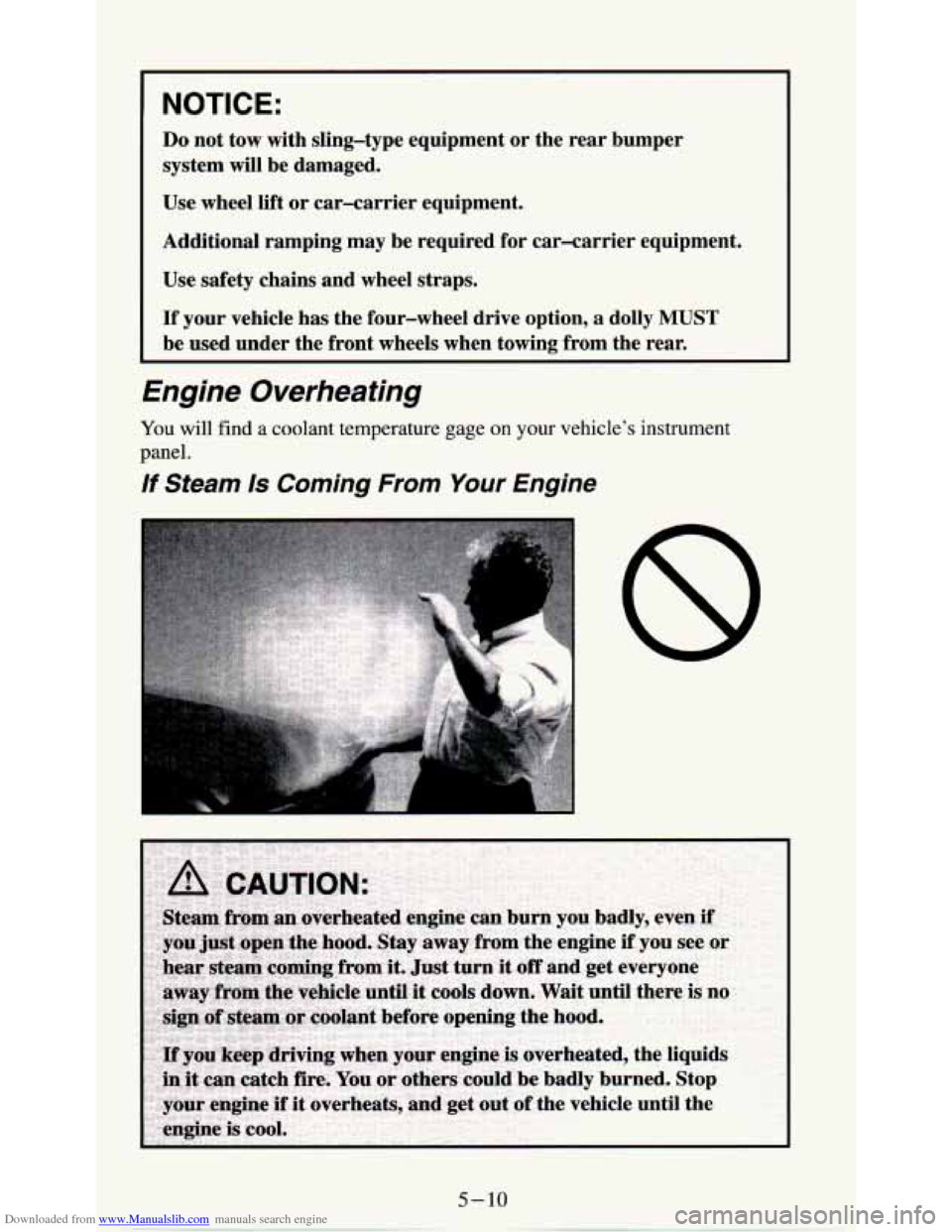
Downloaded from www.Manualslib.com manuals search engine I
NOTICE:
Do not tow with sling-type equipment or the rear bumper
system will be damaged.
Use wheel lift or car-carrier equipment.
Additional ramping may be required for car-carrier equipment.
Use safety chains and wheel straps.
If your vehicle has the four-wheel drive option, a dolly MUST
be used under the front wheels when towing from the rear.
Engine Overheating
You will find a coolant temperature gage on your vehicle's instrument
panel.
If Steam Is Coming From Your Engine
Page 194 of 354
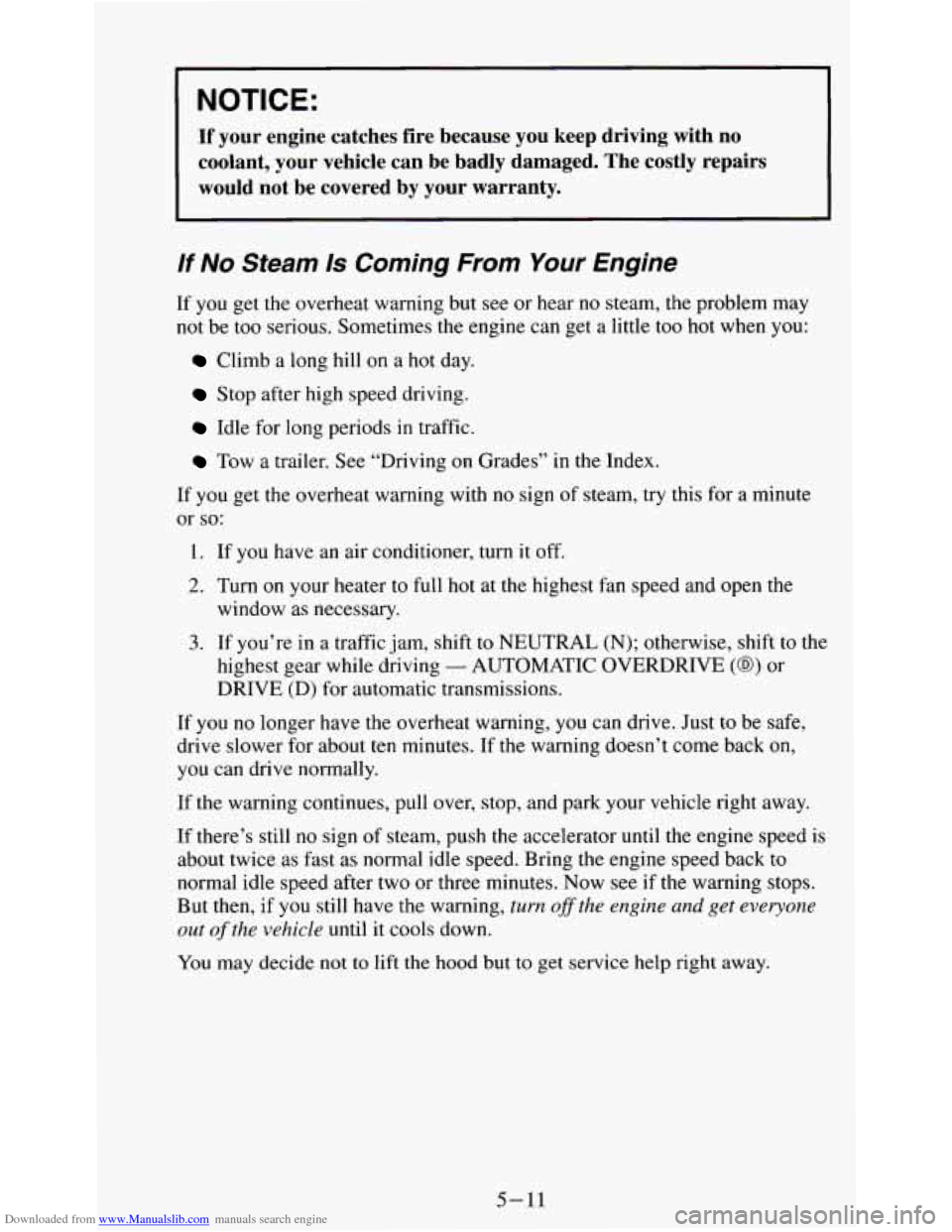
Downloaded from www.Manualslib.com manuals search engine If your engine catches fire because you keep driving with no
coolant, your vehicle can be badly damaged. The costly repairs \
would not be covered by your warranty.
If No Steam Is Coming From Your Engine
If you get the overheat warning but see or hear no steam, the problem may
not be too serious. Sometimes the engine can get a little too hot when you:
Climb a long hill on a hot day.
Stop after high speed driving.
Idle for long periods in traffic.
Tow a trailer. See “Driving on Grades’’ in the Index.
If you get the overheat warning with
no sign of steam, try this for a minute
or
so:
1. If you have an air conditioner, turn it off.
2. Turn on your heater to full hot at the highest fan speed and open the
window as necessary.
3. If you’re in a traffic jam, shift to NEUTRAL (N); otherwise, shift to the
highest gear while driving
- AUTOMATIC OVERDRIVE (0) or
DRIVE
(D) for automatic transmissions.
If
you no longer have the overheat warning, you can drive. Just to be safe,
drive slower for about
ten minutes. If the warning doesn’t come back on,
you can drive normally.
If the warning continues, pull over, stop, and park your vehicle right away.
If there’s still no sign of steam, push
the accelerator until the engine speed is
about twice as fast as normal idle speed. Bring the engine speed back to
normal idle speed after two or three minutes. Now see
if the warning stops.
But then, if
you still have the warning, turn ofSthe engine and get everyone
out of the vehicle until it cools down.
You may decide not to lift the hood but to get service help right away.
5-11
Page 197 of 354
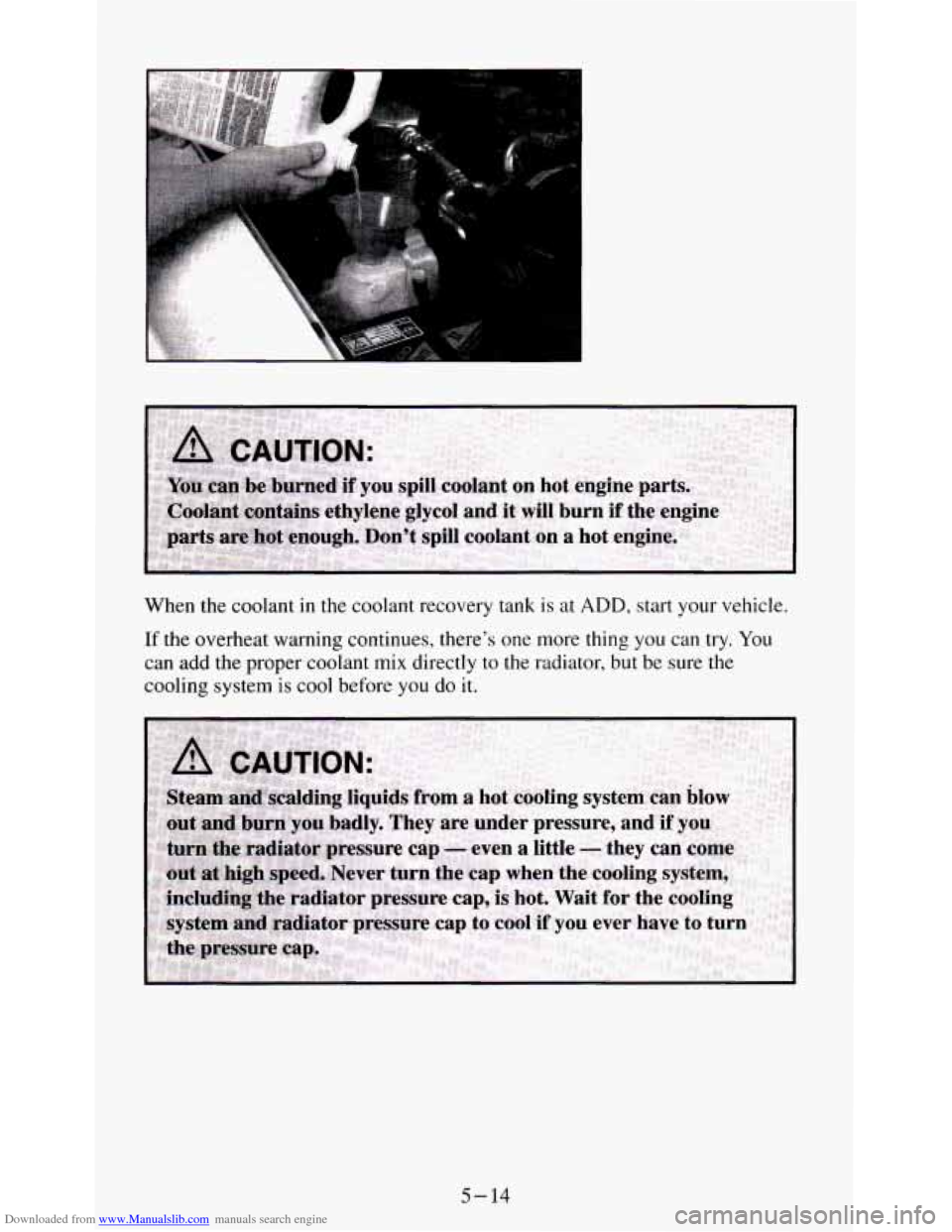
Downloaded from www.Manualslib.com manuals search engine When the coolant in the coolant recovery tank is at ADD, start your vehicle.
If the overheat warning continues, there's one more thing you can try. You
can add the proper coolant mix directly to the radiator, but be sure the
cooling system is cool before you do it.
5-14
Page 238 of 354
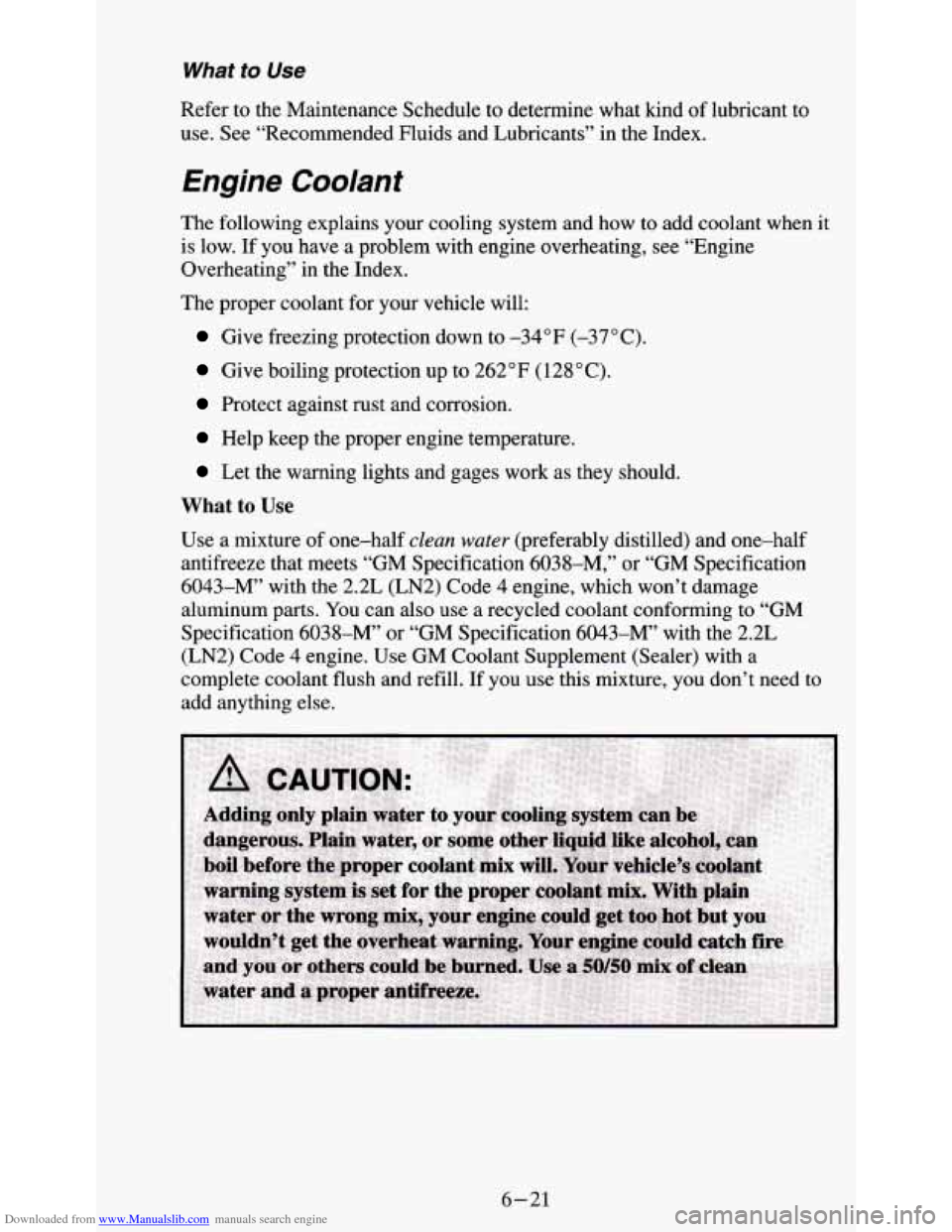
Downloaded from www.Manualslib.com manuals search engine What to Use
Refer to the Maintenance Schedule to determine what kind of lubricant to
use. See “Recommended Fluids and Lubricants” in the Index.
Engine Coolant
The following explains your cooling system and how to add coolant when it
is low. If you have a problem with engine overheating, see “Engine
Overheating” in the Index.
The proper coolant for your vehicle will:
Give freezing protection down to -34°F (-37 “C).
Give boiling protection up to 262°F (128 “C).
Protect against rust and corrosion.
Help keep the proper engine temperature.
Let the warning lights and gages work as they should.
What to Use
Use a mixture of one-half clean water (preferably distilled) and one-half
antifreeze that meets “GM Specification 6038-M,” or “GM Specification
6043-M’ with the 2.2L (LN2) Code 4 engine, which won’t damage
aluminum parts.
You can also use a recycled coolant conforming to “GM
Specification 603%”’ or “GM Specification 6043-M” with the 2.2L
(LN2) Code 4 engine. Use GM Coolant Supplement (Sealer) with a
complete coolant flush and refill. If you use this mixture, you don’t need to
add anything else.
6-21
Page 239 of 354
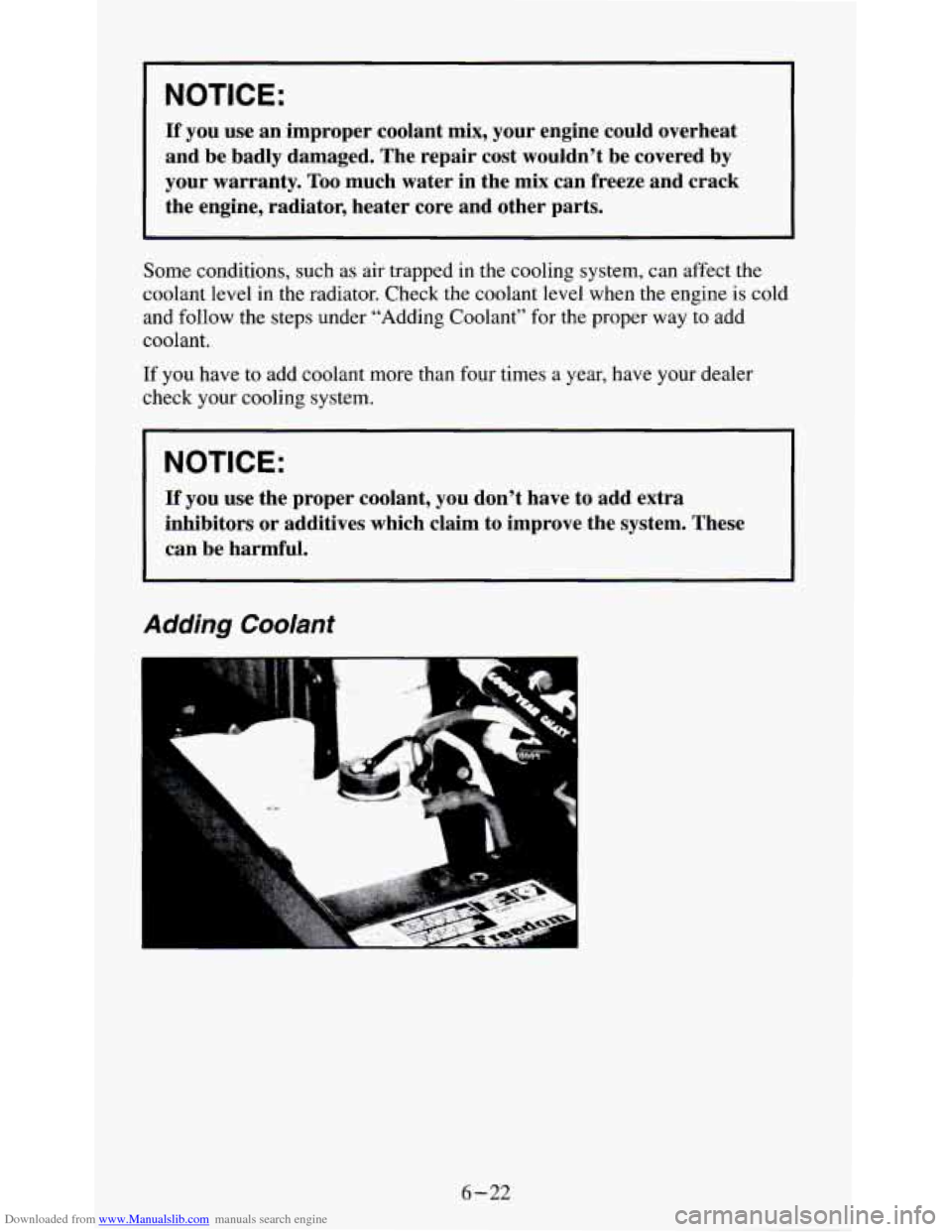
Downloaded from www.Manualslib.com manuals search engine NOTICE:
If you use an improper coolant mix, your engine could overheat
and be badly damaged. The repair cost wouldn’t be covered by
your warranty. Too much water in the mix can freeze and crack
the engine, radiator, heater core and other parts.
Some conditions, such as air trapped in the cooling system, can affect the
coolant level in the radiator. Check the coolant level when the engine is cold
and follow the steps under “Adding Coolant” for the proper way to add
coolant.
If you have to add coolant more than four times a year, have your dealer
check your cooling system.
NOTICE:
If you use the proper coolant, you don’t have to add extra
inhibitors or additives which claim to improve the system. These
can be harmful.
Adding Coolant
E I
6-22
Page 240 of 354
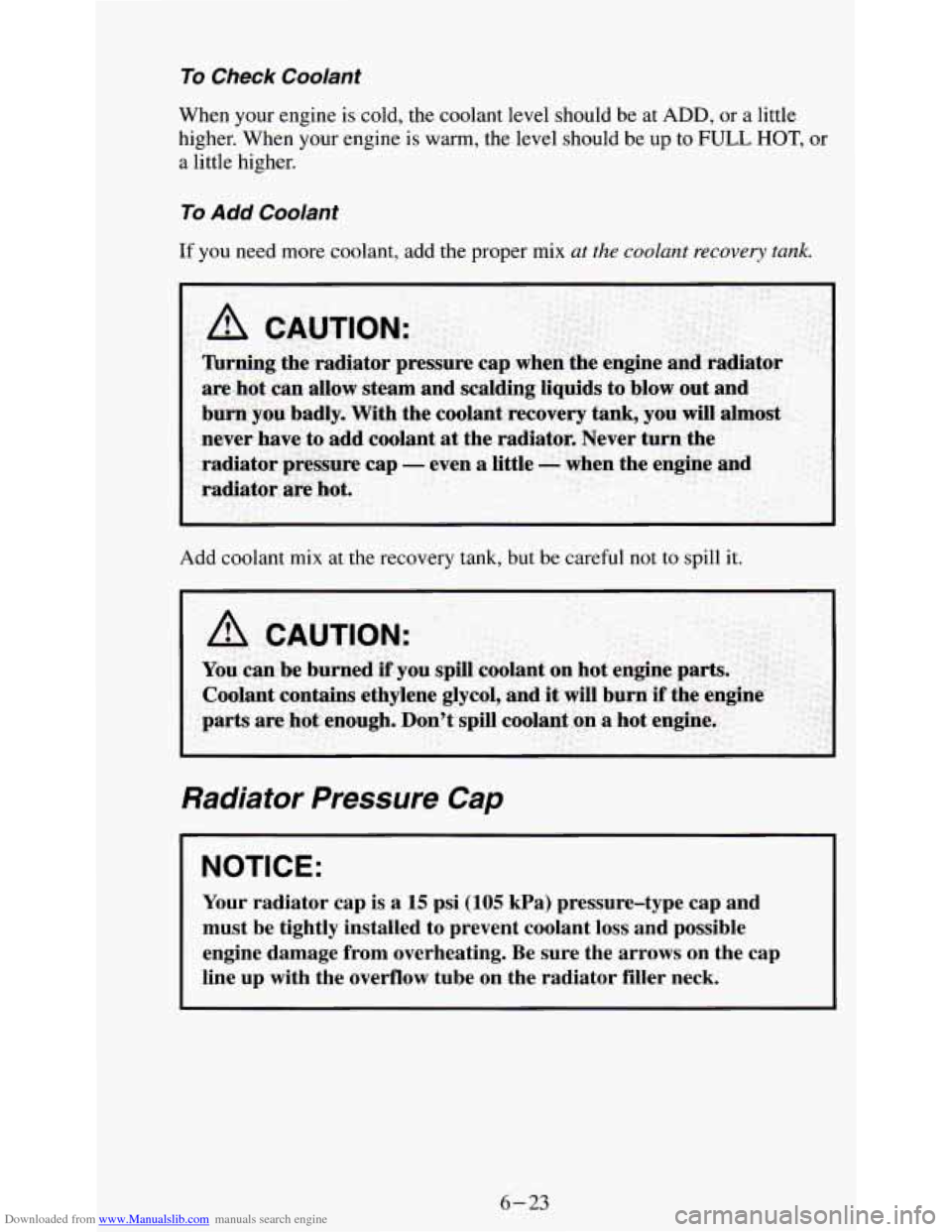
Downloaded from www.Manualslib.com manuals search engine To Check Coolant
When your engine is cold, the coolant level should be at ADD, or a little
higher. When
your engine is warm, the level should be up to FULL HOT, or
a little higher.
To Add Coolant
If you need more coolant, add the proper mix at the coolant recovery tank.
Add coolant mix at the recovery tank, but be careful not to spill it.
Radiator Pressure Cap
NOTICE:
Your radiator cap is a 15 psi (105 kPa) pressure-type cap and
must be tightly installed to prevent coolant loss and possible \
engine damage from overheating. Be sure the arrows on the cap \
line up with the overflow tube on the radiator filler neck.
6-23
Page 277 of 354
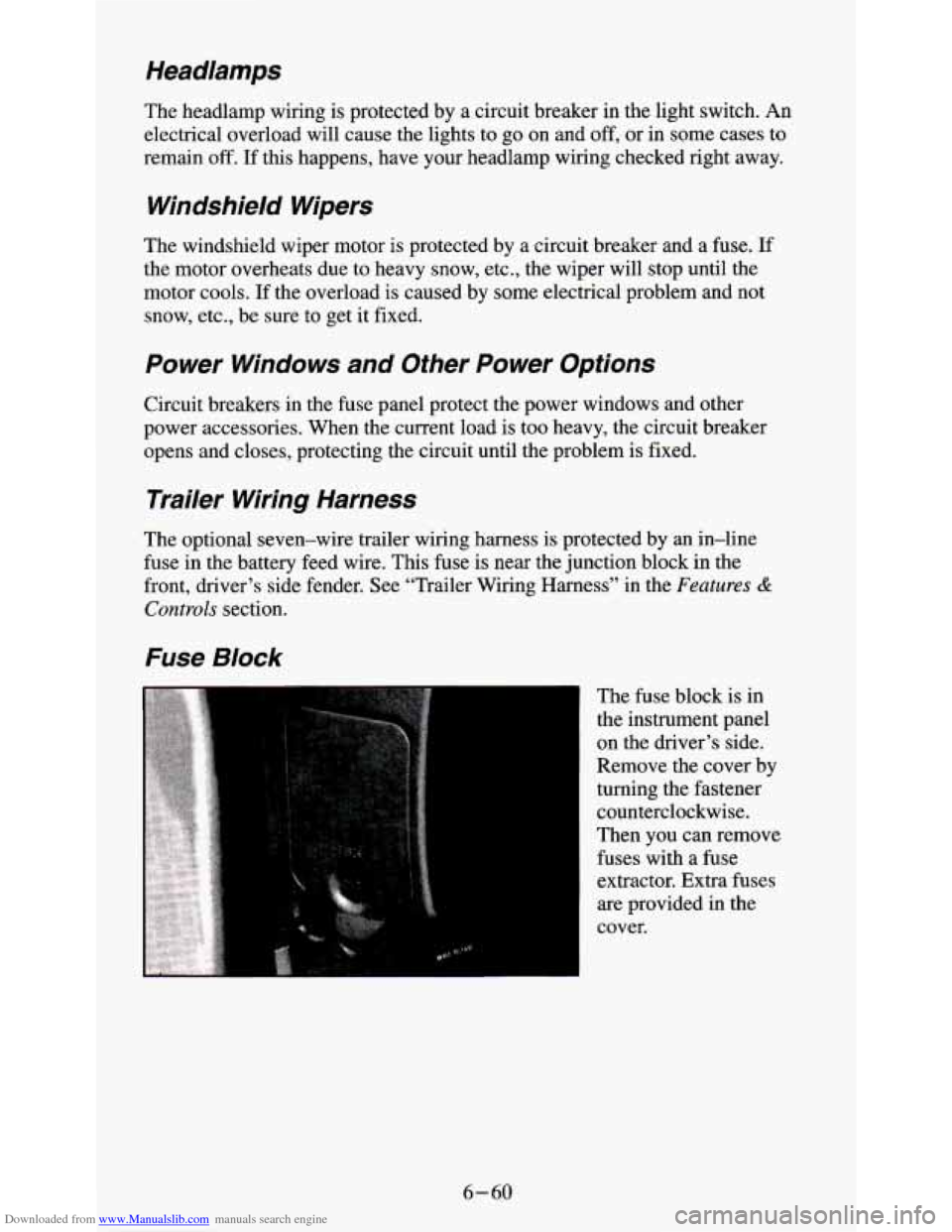
Downloaded from www.Manualslib.com manuals search engine Headlamps
The headlamp wiring is protected by a circuit breaker in the light switch. An
electrical overload will cause the lights to go on and
off, or in some cases to
remain off. If this happens, have your headlamp wiring checked right away.
Windshield Wipers
The windshield wiper motor is protected by a circuit breaker and a fuse. If
the motor overheats due to heavy snow, etc., the wiper will stop until the
motor cools. If the overload is caused by some electrical problem and not
snow, etc., be sure to get it fixed.
Power Windows and Other Power Options
Circuit breakers in the fuse panel protect the power windows and other
power accessories. When the current load is too heavy, the circuit breaker
opens and closes, protecting the circuit until the problem is fixed.
Trailer Wiring Harness
The optional seven-wire trailer wiring harness is protected by an in-line
fuse in the battery feed wire. This fuse is near the junction block in the
front, driver’s side fender. See “Trailer Wiring Harness”
in the Features &
Controls section.
Fuse Block
. .. . .,
The fuse block is in
the instrument panel
on the driver’s side.
Remove the cover by
turning the fastener
counterclockwise.
Then you can remove
fuses with a fuse
extractor. Extra fuses
are provided in the
cover.
6-60
Page 346 of 354
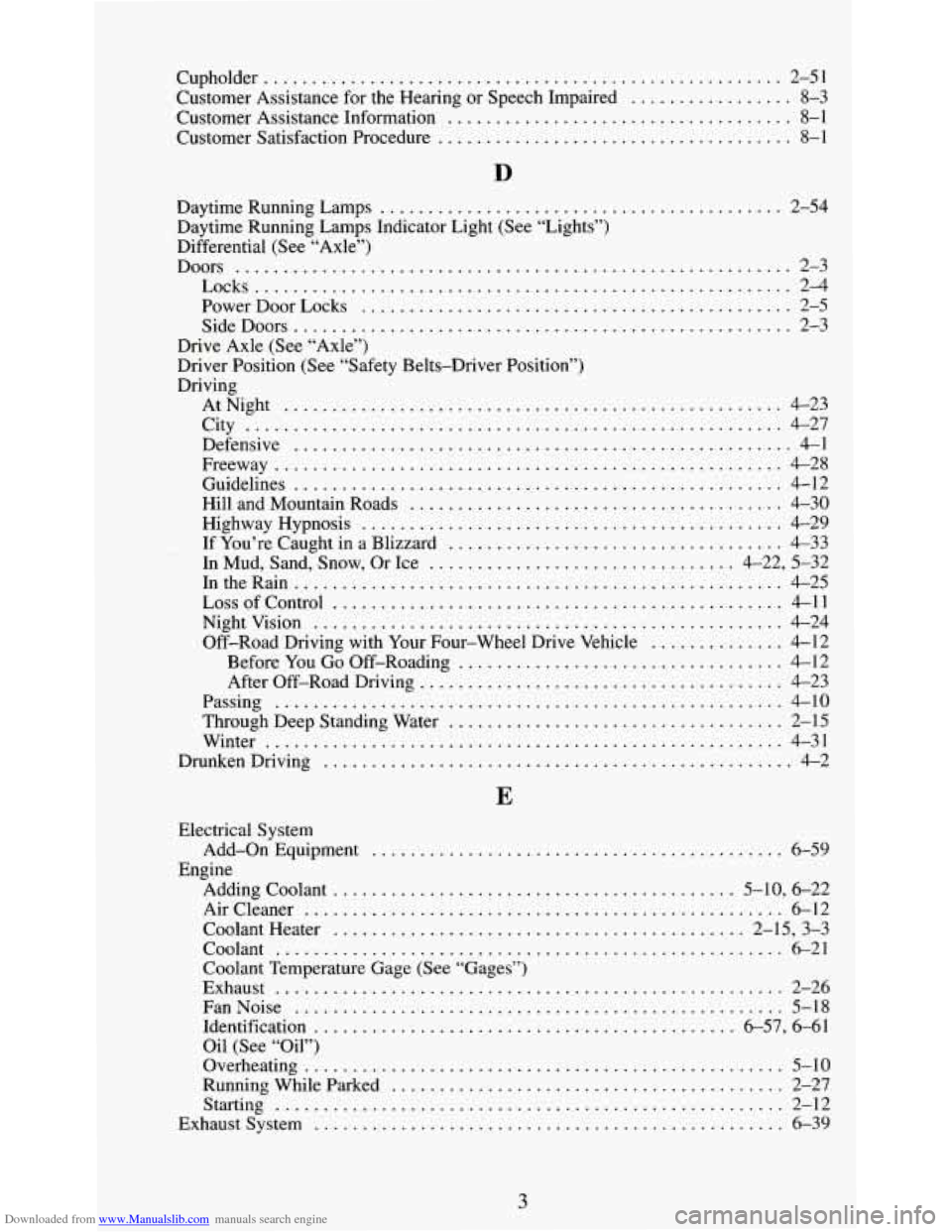
Downloaded from www.Manualslib.com manuals search engine Cupholder ...................................................... 2-51
Customer Assistance Information
.................................... 8-1
Customer Satisfaction Procedure
..................................... 8-1
Customer Assistance for
the Hearing or Speech Impaired
................. 8-3
Daytime Running Lamps
.......................................... 2-54
Daytime Running Lamps Indicator Light (See “Lights”)
Differential (See “Axle”)
Doors
.......................................................... 2-3
Locks
........................................................ 2-4
PowerDoorLocks
............................................. 2-5
SideDoors
.................................................. 2-3
Drive Axle (See “Axle”)
Driver Position (See “Safety Belts-Driver Position”)
Driving AtNight
.................................................... 4-23
City
........................................................ 4-27
Defensive
.................................................... 4-1
Freeway
..................................................... 4-28
Guidelines
................................................... 4-12
Hill and Mountain Roads
....................................... 4-30
Highway Hypnosis
............................................ 4-29
If You’re Caught in a Blizzard
................................... 4-33
In Mud, Sand, Snow, Or Ice
................................ 4-22, 5-32
IntheRain
................................................... 4-25
LossofControl
............................................... 4-11
Off-Road Driving with Your Four-wheel Drive Vehicle
.............. 4-12
Before
You Go Off-Roading .................................. 4-12
After Off-Road Driving
...................................... 4-23
Passing
..................................................... 4-10
Through Deep Standing Water ................................... 2-15
Winter
...................................................... 4-31
DrunkenDriving
................................................. 4-2
Nightvision
................................................. 4-24
Electrical System
Engine Add-on
Equipment
................. ..................... 6-59
Adding Coolant
........................................ 5.10. 6.22
Air Cleaner
.................................................. 6-12
Coolant Heater
........................................... 2-1 5. 3-3
Coolant
..................................................... 6-21
Coolant Temperature Gage
(See “Gages”)
Exhaust
..................................................... 2-26
FanNoise
................................................... 5-18
Identification .......................................... 6.57, 6.6 1
Oil (See “Oil”)
Overheating
.................................................. 5-10
RunningWhileParked
......................................... 2-27
Starting
..................................................... 2-12
Exhaustsystem
................................................. 6-39
3